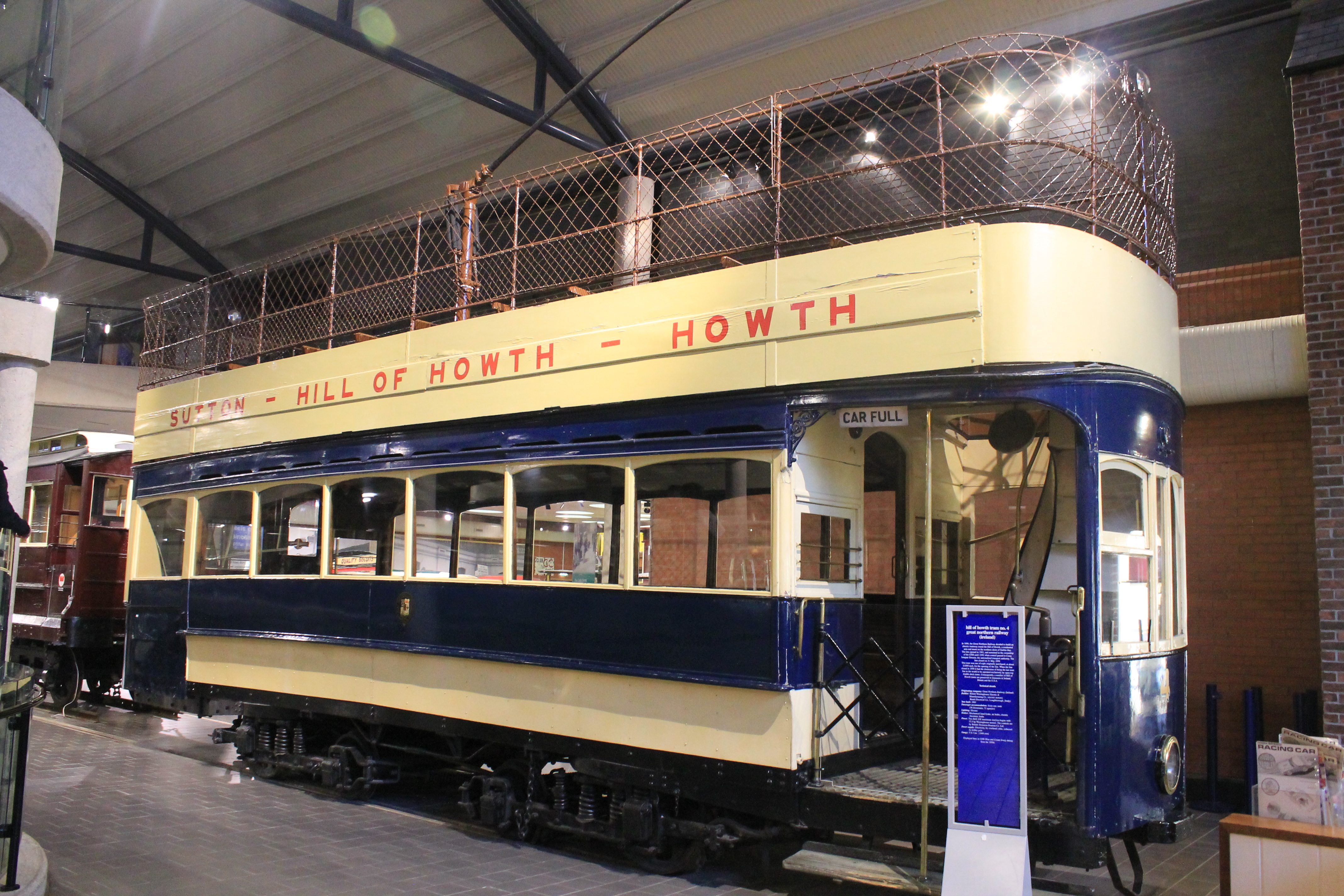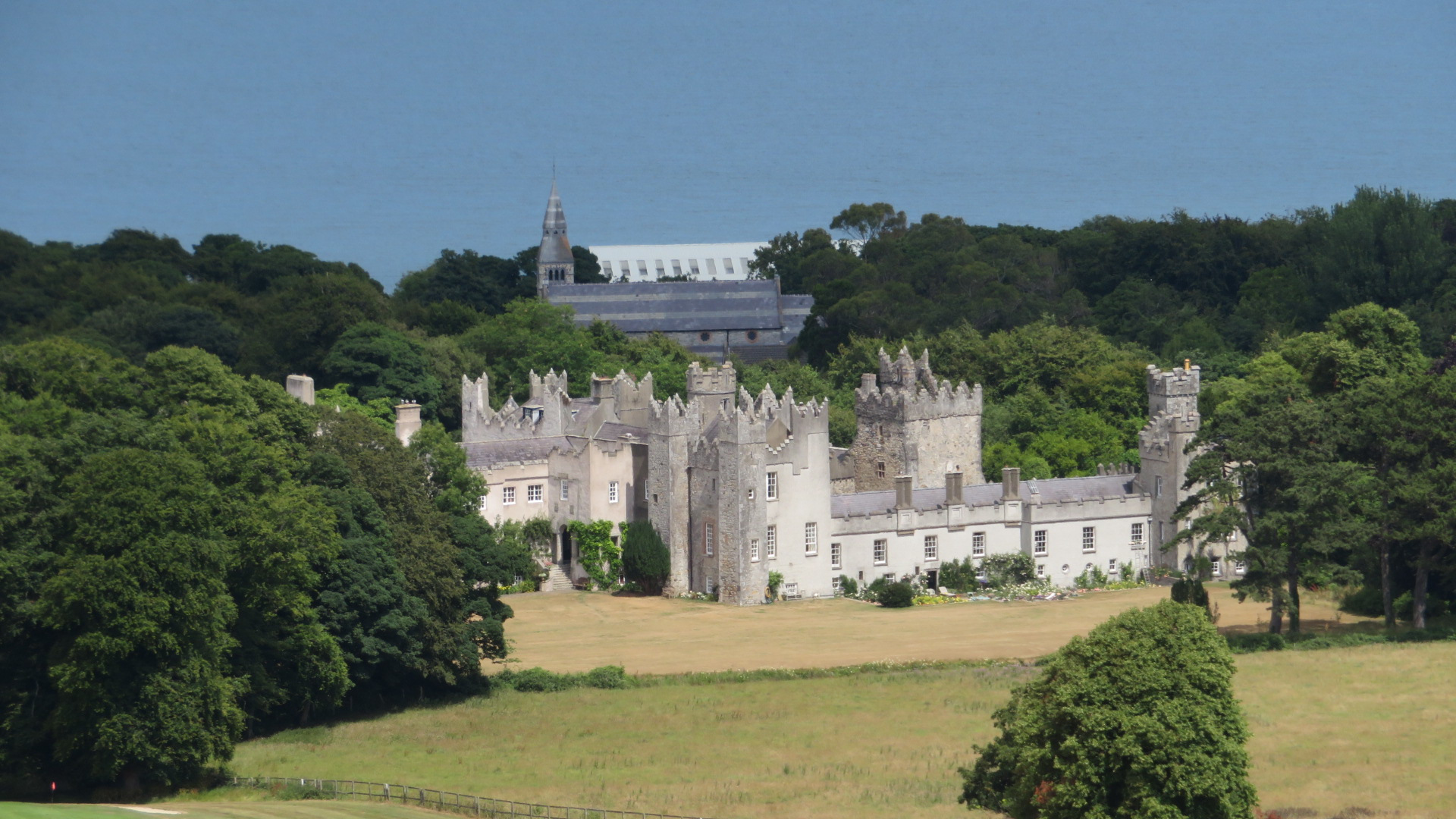|
Hill Of Howth Tramway
The Howth Tram on the Hill of Howth Tramway was a tram which served Howth Head, near Dublin, Ireland. The termini were at Sutton railway station, Dublin, Sutton railway station, by the entrance to the peninsula, and Howth railway station by the village and harbour of Howth. Design The line of the route was designed in-house by the Great Northern Rail staff at their Dublin office, under William Hemingway Mills, chief engineer. The engineer responsible for the detailed design was Joshua Harrison Hargrave, the famous Cork-born photographer/engineer. History The service operated from June 1901 to 31 May 1959 and was run by the Great Northern Railway (Ireland) (GNR(I)), which viewed it as a way to bring more customers to its railway stations at Sutton, Dublin, Sutton and Howth. The tramway replaced a horse bus service, which had run since 1867. Closure and replacement On 1 October 1958, Córas Iompair Éireann (CIÉ) took over GNR(I)'s operations in the Republic of Ireland, includ ... [...More Info...] [...Related Items...] OR: [Wikipedia] [Google] [Baidu] |
Howth Castle
Howth Castle ( ) and estate lie just outside the village of Howth, County Dublin in Ireland, in the administration of Fingal County Council. The castle was the ancestral home of the line of the St Lawrence family (see: Earl of Howth) that had held the area since the Norman Invasion of 1180, and held the title of Lord of Howth until circa 1425, the Baron Howth to 1767, then Earl of Howth until 1909. The castle and estate are held since 1909 by their distaff heirs, the Gaisford-St Lawrence family. The estate includes much of the peninsula of Howth Head, including extensive heathland and much of Howth's cliff walks, with views over Dublin Bay, light woodland, and the island of Ireland's Eye. On the grounds near the castle are golf, pitch and putt and footgolf facilities, a former hotel, formal gardens and a pond, rhododendron walks - and several small streams pass through the estate. In October 2018, the family announced their agreement to sell the castle, demesne and Ireland's ... [...More Info...] [...Related Items...] OR: [Wikipedia] [Google] [Baidu] |
Track Gauge In Ireland
The track gauge adopted by the mainline railways in Ireland is . This unusually broad track gauge is otherwise found only in Australia (where it was introduced by the Irish railway engineer F. W. Sheilds), in the states of Victoria, southern New South Wales (via some extensions of the Victorian rail network) and South Australia, as well as in Brazil. The Grand Duchy of Baden State Railway used this gauge between 1840 and 1855, as did the Canterbury Provincial Railways in New Zealand, until conversion to the gauge in the 1860s. The Launceston and Western Railway in Tasmania also used this gauge from 1871, until conversion to gauge in 1888. Different gauges Ireland's first railway, the Dublin and Kingstown, was built to (later known as standard gauge). The Ulster Railway (UR), taking the Irish Railway Commission's advice, used . The Dublin and Drogheda Railway was proposed to be built to gauge on the grounds of lower costs. The two broader gauges were not used anywhere e ... [...More Info...] [...Related Items...] OR: [Wikipedia] [Google] [Baidu] |
Baily Lighthouse
The Baily Lighthouse (Irish: ''Teach Solais Dhún Criofainn'') is a lighthouse on the southeastern part of Howth Head in County Dublin, Ireland. It is maintained by the Commissioners of Irish Lights. History Early history The first lighthouse on this site was built in about 1667 by Sir Robert Reading, and was one of six that Reading had received letters patent to build from Charles II in 1665. The original facility consisted of a small cottage and a square tower which supported a coal-fired beacon. Parts of the original buildings remain. In 1790, the coal beacon was replaced with a set of six Argand oil lamps, each including a silvered copper parabolic and a bulls-eye glass pane. During this period, the lighthouse was maintained by the Revenue Commissioners. New site In 1810, the Corporation for Preserving and Improving the Port of Dublin took over the operations. The original building's location was high on the headland, so the light was often obscured by fog. On 5 Dece ... [...More Info...] [...Related Items...] OR: [Wikipedia] [Google] [Baidu] |
Greenfield Road, Dublin
Sutton ( ga, Cill Fhionntain – Fintan's cell or church) is a residential suburb on the Northside of Dublin, Ireland. It occupies the tombolo which links Howth Head to the mainland, some of the lower slopes of Howth Hill, and a little of the adjacent coasts. The area lies within the jurisdiction of Fingal County Council. There is a small commercial core at the Sutton Cross road intersection. Sutton lies in the ancient Barony of Coolock, within the historic County Dublin. History The first recorded mention of Sutton in reference to the area is from around 1228-48, noted in the Calendar of Archbishop Alen's Register; it is likely linked to a person of Norman origin. Location and geography Location Historically Sutton lay entirely on the Howth peninsula, from Sutton Cross up to Claremont Road and where Barren Hill meets Carrickbrack Road and the Martello Tower at Red Rock. Today, however, it is generally considered to extend to the railway, where it meets Baldoyle, and to ... [...More Info...] [...Related Items...] OR: [Wikipedia] [Google] [Baidu] |
Double-decker Tram
A double-decker tram or double-deck tram is a tram that has two levels or decks. Some double-decker trams have open tops. Double-deck trams were once popular in some European cities, like Berlin and London, throughout the British Empire countries in the early half of the 20th century including Auckland, Christchurch and Wellington in New Zealand; Hobart, Tasmania in Australia and in parts of Asia. They are still in service or even newly introduced in Hong Kong, Alexandria, Dubai, Oranjestad, Blackpool, Birkenhead, Franschhoek, Auckland and Douglas, mostly as heritage or tourist trams. History Heyday The earliest double-deck trams were horse-drawn. The first electric double-deck trams were those built for the Blackpool Tramway in 1885, where Conduit tramcar No. 4 is the sole survivor of its class and is preserved at the National Tramway Museum in Crich, UK. They were common in the United Kingdom until the 1950s. London Transport was a heavy user of double-deck trams until th ... [...More Info...] [...Related Items...] OR: [Wikipedia] [Google] [Baidu] |
Howth Tram Map, 1922
Howth ( ; ; non, Hǫfuð) is an affluent peninsular village and outer suburb of Dublin, Ireland. The district as a whole occupies the greater part of the peninsula of Howth Head, which forms the northern boundary of Dublin Bay, and includes the island of Ireland's Eye, which holds multiple natural protection designations. Howth has been settled since prehistoric times, and features in Irish mythology. A fishing village and small trading port from at least the 14th century, Howth has grown to become a busy and affluent suburb of Dublin, with a mix of suburban residential development, wild hillside and heathland, golf courses, cliff and coastal paths, a small quarry and a busy commercial fishing port. The only neighbouring district on land is Sutton. Howth is also home to one of the oldest occupied buildings in Ireland, Howth Castle, and its estate. Howth is also a civil parish in the ancient barony of Coolock. Location and access Howth is located on the peninsula of Howt ... [...More Info...] [...Related Items...] OR: [Wikipedia] [Google] [Baidu] |
United States
The United States of America (U.S.A. or USA), commonly known as the United States (U.S. or US) or America, is a country primarily located in North America. It consists of 50 states, a federal district, five major unincorporated territories, nine Minor Outlying Islands, and 326 Indian reservations. The United States is also in free association with three Pacific Island sovereign states: the Federated States of Micronesia, the Marshall Islands, and the Republic of Palau. It is the world's third-largest country by both land and total area. It shares land borders with Canada to its north and with Mexico to its south and has maritime borders with the Bahamas, Cuba, Russia, and other nations. With a population of over 333 million, it is the most populous country in the Americas and the third most populous in the world. The national capital of the United States is Washington, D.C. and its most populous city and principal financial center is New York City. Paleo-Americ ... [...More Info...] [...Related Items...] OR: [Wikipedia] [Google] [Baidu] |
California
California is a U.S. state, state in the Western United States, located along the West Coast of the United States, Pacific Coast. With nearly 39.2million residents across a total area of approximately , it is the List of states and territories of the United States by population, most populous U.S. state and the List of U.S. states and territories by area, 3rd largest by area. It is also the most populated Administrative division, subnational entity in North America and the 34th most populous in the world. The Greater Los Angeles area and the San Francisco Bay Area are the nation's second and fifth most populous Statistical area (United States), urban regions respectively, with the former having more than 18.7million residents and the latter having over 9.6million. Sacramento, California, Sacramento is the state's capital, while Los Angeles is the List of largest California cities by population, most populous city in the state and the List of United States cities by population, ... [...More Info...] [...Related Items...] OR: [Wikipedia] [Google] [Baidu] |
Southern California Railway Museum
The Southern California Railway Museum (SCRM, reporting mark OERX), formerly known as the Orange Empire Railway Museum, is a railroad museum in Perris, California, United States. It was founded in 1956 at Griffith Park in Los Angeles before moving to the former Pinacate, California, Pinacate Station as the "Orange Empire Trolley Museum" in 1958. It was renamed "Orange Empire Railway Museum" in 1975 after merging with a museum then known as the California Southern Railroad Museum, and adopted its current name in 2019. The museum also operates a heritage railway, heritage railroad on the museum grounds. Background The collection focuses on Southern California's railroad history. It houses the largest collection of Pacific Electric Railway rolling stock in the world, much of it rescued from scrapyards after the discontinuation of their passenger operations in 1961. Two early Los Angeles, California, Los Angeles Narrow gauge railway, narrow gauge Tram, streetcars from the Los Angeles ... [...More Info...] [...Related Items...] OR: [Wikipedia] [Google] [Baidu] |
Standard Gauge
A standard-gauge railway is a railway with a track gauge of . The standard gauge is also called Stephenson gauge (after George Stephenson), International gauge, UIC gauge, uniform gauge, normal gauge and European gauge in Europe, and SGR in East Africa. It is the most widely used track gauge around the world, with approximately 55% of the lines in the world using it. All high-speed rail lines use standard gauge except those in Russia, Finland, and Uzbekistan. The distance between the inside edges of the rails is defined to be 1435 mm except in the United States and on some heritage British lines, where it is defined in U.S. customary/Imperial units as exactly "four feet eight and one half inches" which is equivalent to 1435.1mm. History As railways developed and expanded, one of the key issues was the track gauge (the distance, or width, between the inner sides of the rails) to be used. Different railways used different gauges, and where rails of different gauge met – ... [...More Info...] [...Related Items...] OR: [Wikipedia] [Google] [Baidu] |



